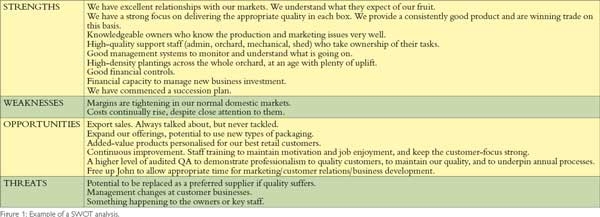SWOT analysis (continued from last month)
The final tool is a business planning favourite—the SWOT analysis; standing for Strengths, Weaknesses, Opportunities and Threats.
Completing a SWOT analysis comes from a little soul-searching and is best done with input from other family members and, perhaps, key staff members.
It is a simple way of identifying some critical elements that impact on the business, from which it is possible to determine some important messages.
It will look something like Figure 1. From this analysis, we can develop some key messages:
Strategic issues
What do we need to do to maintain and improve our people?
- Training around continuous improvement
- Develop an understudy to support our orchard manager
- Trip to New Zealand to review latest developments.
What do we need to do to maintain and improve our offerings?
- Undertake fact-finding trip to SE Asia
- Investigate alternative packaging options
- Ensure that shed staff are good enough to take on new tasks/products
- Undertake an advanced QA system.
What do we need to do to strengthen the business?
- Complete the family succession plan and estate planning process
- Continue paying down debt.
As can be seen from these comments, a number of these items are large investments of time and money. So, the reality is that a SWOT analysis does not have to be a drawn-out, complex job. It just has to identify a small number of activities each year which have the potential to improve business strength if done well.
Conclusion
Given all the tasks that have to be done in a year, it is easy for time to slip past and put pressure on decision-making.
In addition, strategic decision-making in many businesses is done informally and may depend more on gut feel and external advice than on informed analysis.
The foregoing tools are offered as some simple methods of helping to put the big decisions in context.
They are not difficult to prepare, they offer talking points for the family and can be easily updated each year once they have been prepared.
They provide a platform for further discussion with the bank manager or accountant, and so could quickly become quite robust little pictures of the business.
About a single page for each should do it.
See this article in Tree Fruit Jan 2016






















